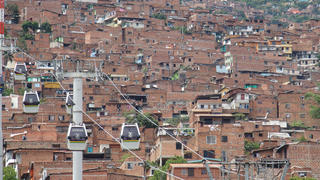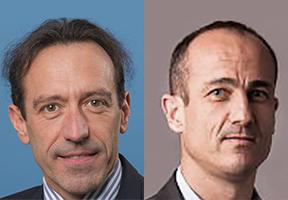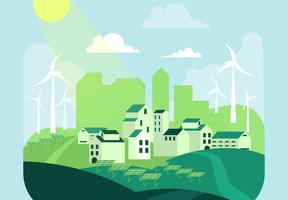Medellín: Public Transportation for Social Change
10 min read
The city of Medellín, Colombia is cited as an example around the world for the policies it has put in place to reduce favelas, the term used for deprived neighborhoods in large South American cities. What makes this success story for social change so unique is the importance placed on public transportation and urban renovation.

© SHUTTERSTOCK - Medellín's urban cable car system has opened up poor hillside areas.
With 3.7 million inhabitants, Medellín is the second largest city in Colombia after the country’s capital, Bogotá. It is situated 1,500 meters above sea level in a huge natural basin, whose steep slopes are home to some of the city’s poorest communities. Deprived suburbs such as these are a widespread phenomenon in Latin America, which is now the most urbanized continent in the world. They started to spring up in Medellín and elsewhere when, in the 1950s, people from rural regions began steadily moving to cities.
For years, urban planning was completely neglected by local authorities, forcing certain communities to build makeshift housing “horizontally” in the city’s outskirts, leading to thousands of hectares of favelas (as they are known in Brazil) or barrios (in Spanish), with no transportation infrastructure or public services. In Medellín, they became no-go zones controlled by drug cartels, including the network run by Pablo Escobar, who was one of the most significant contributors to drug trafficking worldwide.
From 1995 onward, the biggest cartels were disbanded and various local governments across the political spectrum embarked on programs to rehabilitate the areas and fight against poverty, in a concept dubbed “social urbanism”. Their ongoing efforts were recognized in 2013, when Medellín beat New York and Tel Aviv to the title “Innovative City of the Year”, awarded by the Wall Street Journal and two urban planning institutes. Medellín has also won a number of other prizes, confirming its place as a leading city for urban development.
The Key Role of Public Transportation
Transportation infrastructure was key in opening up poor areas. As the steep slopes and sprawling, unstructured neighborhoods rendered buses impossible, the decision was made in 2003 to implement Metrocable, a cable car system similar to those used in ski stations. Four lines1 were installed one by one and are now used by an average of 70,000 passengers per day, traveling at 18 kilometers per hour. A huge escalator measuring nearly 400 meters long and divided into eight sections has also been built to facilitate access to one of the highest neighborhoods in the city, Comuna 13, which had been one of the most dangerous areas in Medellín.
The Metrocable system also joins up with other transportation networks, including the preexisting metro, a new fleet of buses, articulated for greater capacity, and a rubber tire tram system introduced at the end of 2015 to cover the steep, winding routes. The local authorities see these new means of transportation as a social integration tool for communities which were previously cut off from the rest of the city.
In addition to public transportation, Medellín has also developed urban agriculture, aiming to improve food production and recreate a basic rural presence in the city. For this, the local authorities called upon non-profit organizations. The Salva Terra Foundation, for example, has put in place around 60 vegetable gardens in the city suburbs for families, who keep some of the produce for themselves and sell the rest to earn a small income. A number of green spaces have also been created.
At the same time, successive local governments have commissioned residential buildings to densify urban areas and make them more “vertical”, in an attempt to stop the sprawl of poor neighborhoods. A program to build schools, public libraries and culture centers for young people has also been put in place, rounding off the city’s efforts to improve social conditions.
Although it was centered on public transportation, Medellín’s urban renovation program has had a remarkable side effect: an increase in the number of motor vehicles, which doubled between 2005 and 2015. A large proportion of this rise was due to motorcycles, the number of which increased by 300% in the same period.
As a result, the “City of the Eternal Spring”, as it is known thanks to its mild temperatures, which hover between 18 and 28°C throughout the year, has become heavily polluted. Local authorities have introduced frequent measures to ration road space or temporarily restrict vehicle access. However, smog is worsened by the El Niño climate phenomenon, which regularly causes drought in Colombia.
Sources:
- See images of the cable car system here (in French only)






















